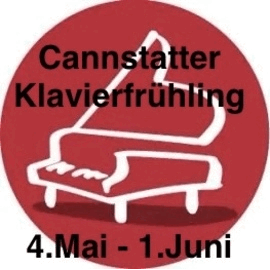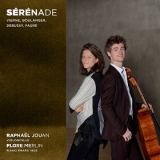 Sérénade; Gabriel Fauré: Sérénade pour piano et violoncelle, op. 98 + Deuxième Sonate pour violoncelle et piano op. 117; Louis Vierne: Sonate pour violoncelle et piano, op. 27; Nadia Boulanger: Trois pièces; Debussy: Sonate pour violoncelle et piano; Raphaël Jouan, Cello, Flore Merlin, Klavier; 1 CD Initiale INL06; Aufnahme 11/2019, Veröffentlichung 11/12/2020 (Digital 06/20) - (62') - Rezension von Remy Franck
Sérénade; Gabriel Fauré: Sérénade pour piano et violoncelle, op. 98 + Deuxième Sonate pour violoncelle et piano op. 117; Louis Vierne: Sonate pour violoncelle et piano, op. 27; Nadia Boulanger: Trois pièces; Debussy: Sonate pour violoncelle et piano; Raphaël Jouan, Cello, Flore Merlin, Klavier; 1 CD Initiale INL06; Aufnahme 11/2019, Veröffentlichung 11/12/2020 (Digital 06/20) - (62') - Rezension von Remy Franck
Auf dieser CD erklingt Kammermusik, wie sie eigentlich immer gemacht werden sollte, technisch gut vorbereitet und spontan gespielt, Musik ‘in statu nascendi’, wie improvisiert, in höchstem Grad kommunikativ und stimmungsvoll.
Nach dem flüssig und inspiriert gespielten Appetizer, der kurzen Serenade von Gabriel Fauré, folgt Viernes nicht unproblematische Cellosonate. Man hat sie erhaben starr genannt, mit makellos autoritärer Linie, eine Musik der Rationalität. Das mag nicht ganz zutreffend sein, aber ganz falsch ist es auch nicht. Jouan und Merlin bemühen sich jedenfalls den ersten Satz nicht starr werden zu lassen. Im zweiten Satz hat das lyrisch singende Cello es etwas schwer gegenüber dem babbelnden Klavier, aber Raphaël Jouan lässt sich nicht aus der Ruhe bringen. Im Risoluto-Allegro molto scheren sich die Interpreten weniger um das Risoluto als um Leidenschaftlichkeit und Elan.
Drei reizvolle Stücke von Nadia Boulanger führen zu Debussys Cellosonate, die der Komponist schrieb, als er schon von seiner Krebskrankheit befallen war, die ihn knapp drei Jahre später, 1918, hinwegraffen sollte. Fast rebellisch leitet das Klavier die Sonate ein, das Cello aber führt ins Zärtliche-Verhaltene, mit einem Unterton von Klage. Das Klavier versucht auszubrechen, doch das Cello bezwingt es, kehrt zur intimistischen Ruhe zurück. Was dann im 2. Satz, der Serenade folgt, ist ein Meisterwerk spontanen, quasi improvisatorischen Musizierens, atemberaubend spannend. Eine musikalische Film-im-Kopf Szene, die in den zahlreichen Interpretationen, die ich von diesem skurrilen Satz gehört habe, ihresgleichen nicht findet. Das drängend und pulsierend gespielte Finale mit seinem nachdenklichen Mittelteil ist ebenfalls großartig gelungen in dieser Referenzinterpretation der Debussy-Sonate.
Mit Gabriel Faurés Zweiter Sonate endet diese exzellente und empfehlenswerte CD.
Raphaël Jouans Cellopart ist in dieser Aufnahme eher mit der Interpretation von Alban Gerhardt zu vergleichen als mit jener von Gautier Capuçon. Jouans Spiel ist wach, spontan, schwärmerisch und, ja, risikofreudig. Capuçon hat immer das Ganze im Blick, Jouan musiziert unmittelbarer. Auch der Dialog zwischen ihm und seiner Pianistin Flore Merlin (auf einem übrigens sehr gut klingenden Erard-Flügel von 1903) funktioniert sehr gut. Während die Parts in manchen Interpretationen fein säuberlich getrennt wirken, ist das Zusammenspiel von Jouan und Merlin sehr kreativ, weil mal der eine, mal die andere führt und die Zusammenarbeit nicht so linear wirkt, wie bei anderen Musikern, bei denen man eher ein Cello mit Klavierbegleitung wahrnimmt. Jouan singt das Adagio ohne Pathos, ausdrucksstark sehr differenziert und stellt sich voll dem Dialog mit dem Klavier.
Das Allegro vivo ist quirlig, flüssig und eloquent, mit wiederum einer idealen « Reibung » der beiden Instrumente. Und so geht diese wirklich herausragende CD ebenso faszinierend zu Ende wie sie begann. Sehr empfehlenswert!
On this CD you will hear chamber music as it should always be played, technically well prepared and spontaneously played, music ‘in statu nascendi’, as if improvised, highly communicative and atmospheric.
After a fluent and inspired Appetizer, the short Serenade by Gabriel Fauré, Raphaël Jouan and Flore Merlin perform Vierne’s not unproblematic Cello Sonata. It has been called rigid, with a flawlessly authoritarian line, a music of rationality. That may not be entirely true, but it is not entirely false either. In any case, Jouan and Merlin try hard not to let the first movement become rigid. In the second movement, the lyrically singing cello faces a babbling piano, but Raphaël Jouan does not allow himself to be disturbed. In the Risoluto-Allegro molto, the performers are less concerned with the risoluto than with passion and élan.
Three charming pieces by Nadia Boulanger lead to Debussy’s Cello Sonata, which the composer wrote when he suffered from cancer, which would take him away almost three years later, in 1918. The piano introduces the sonata almost rebelliously, but the cello leads into tenderness, with an undertone of lamentation. The piano tries to break out, but the cello takes control, returning to intimate calm. What then follows in the second movement, the Serenade, is a masterpiece of spontaneous, quasi improvisational music-making, breathtakingly exciting. It’s a musical movie-in-the-head scene unparalleled in the numerous interpretations I have heard of this bizarre movement. The pressing and pulsating finale with its thoughtful middle section is also wonderfully successful in this reference interpretation of the Debussy Sonata.
Gabriel Fauré’s Second Sonata concludes this excellent and highly recommended CD.
Raphaël Jouan’s cello part is more comparable to the interpretation of Alban Gerhardt than to that of Gautier Capuçon. His playing is alert, spontaneous, enthusiastic and, yes, risk-taking. Capuçon always has the whole in view, Jouan plays more directly. The dialogue between him and his pianist Flore Merlin (on a 1903 Erard grand piano that sounds very good, by the way) also works very well. While in some interpretations the parts seem to be neatly separated, the interplay between Jouan and Merlin is very imaginative, because sometimes the cellist leads, sometimes the pianist. The collaboration is not as linear as with other musicians. Jouan sings the Adagio without pathos, expressively very differentiated, and he also fully engages in the dialogue with the piano.
The Allegro vivo is lively, fluid and eloquent, with again an ideal « friction » between the two instruments. And so, this truly outstanding CD ends as fascinatingly as it began. Highly recommended!






















